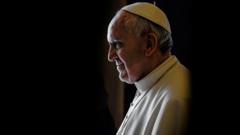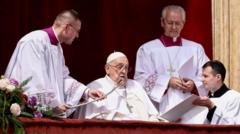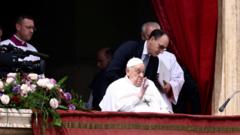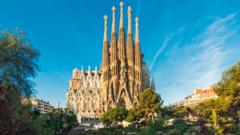The recent passing of Pope Francis has initiated a complex series of traditional rituals that will honor the pontiff’s legacy over several days. Following the pope's death, the Vatican’s health director will confirm the demise, and the camerlengo will execute specific duties, including removing the papal ring, known as the fisherman’s ring, symbolizing St. Peter. This ring is typically destroyed posthumously, leading to the creation of a new one for the incoming pope.
Legacy of Pope Francis: A Look at the Upcoming Papal Funeral and Its Traditions

Legacy of Pope Francis: A Look at the Upcoming Papal Funeral and Its Traditions
As the world prepares for the funeral of Pope Francis, centuries-old traditions surrounding papal funerals will once again come into play, though the exact schedule remains to be set.
After confirmation, the pope's body will be moved to his private chapel at Casa Santa Marta, where Pope Francis had chosen to reside during his papacy, opting for a modest lifestyle instead of the opulent papal apartments. The camerlengo will also seal the pontiff's living and working quarters.
In accordance with tradition, the dean of the College of Cardinals will invite all 252 cardinals globally to Rome to participate in the funeral proceedings and to convene for the subsequent election of a new pope. Pope Francis’s body will lie in state in St. Peter’s Basilica a few days after his death, dressed in papal garments with a white miter, allowing global mourners to pay their final respects.
The public Mass, presided over by Cardinal Giovanni Battista Re, is anticipated to take place within four to six days after the pontiff's death, witnessed by international dignitaries and the faithful alike. Notably, the late pope had streamlined papal funeral practices, reducing the number of coffins from three to only one wooden coffin adorned with zinc lining.
Reflecting on previous papal funerals, Pope Benedict XVI’s service witnessed tens of thousands attending, while Pope John Paul II’s funeral drew nearly two million participants, showcasing the varying public sentiments attached to different papacies. Pope Francis, known for his humble and compassionate approach, will likely see a notable outpouring of grief and remembrance as the world adjusts to a future without his leadership.
Gaia Pianigiani is an Italy-based reporter extensively covering pivotal developments across Europe.
In accordance with tradition, the dean of the College of Cardinals will invite all 252 cardinals globally to Rome to participate in the funeral proceedings and to convene for the subsequent election of a new pope. Pope Francis’s body will lie in state in St. Peter’s Basilica a few days after his death, dressed in papal garments with a white miter, allowing global mourners to pay their final respects.
The public Mass, presided over by Cardinal Giovanni Battista Re, is anticipated to take place within four to six days after the pontiff's death, witnessed by international dignitaries and the faithful alike. Notably, the late pope had streamlined papal funeral practices, reducing the number of coffins from three to only one wooden coffin adorned with zinc lining.
Reflecting on previous papal funerals, Pope Benedict XVI’s service witnessed tens of thousands attending, while Pope John Paul II’s funeral drew nearly two million participants, showcasing the varying public sentiments attached to different papacies. Pope Francis, known for his humble and compassionate approach, will likely see a notable outpouring of grief and remembrance as the world adjusts to a future without his leadership.
Gaia Pianigiani is an Italy-based reporter extensively covering pivotal developments across Europe.























